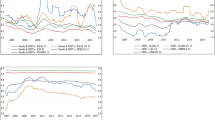Abstract
This paper studies the optimization problem with both investment and proportional reinsurance control under the assumption that the surplus process of an insurance entity is represented by a pure diffusion process. The company can buy proportional reinsurance and invest its surplus into a Black-Scholes risky asset and a risk free asset without restrictions. The authors define absolute ruin as that the liminf of the surplus process is negative infinity and propose absolute ruin minimization as the optimization scenario. Applying the HJB method the authors obtain explicit expressions for the minimal absolute ruin function and the associated optimal investment strategy. The authors find that the minimal absolute ruin function here is convex, but not S-shaped investigated by Luo and Taksar (2011). And finally, from behavioral finance point of view, the authors come to the conclusion: It is the restrictions on investment that results in the kink of minimal absolute ruin function.
Similar content being viewed by others
References
Browne S, Optimal investment policies for a firm with a random risk process: exponential utility and minimizing the probability of ruin, Mathematics of Operations Research, 1995, 20(4): 937–958.
Luo S, Taksar M, and Tsoi A, On reinsurance and investment for large insurance portfolios, Insurance: Mathematics and Economics, 2008, 42(1): 434–444.
Luo S and Taksar M, On absolute ruin minimization under a diffusion approximation model, Insurance: Mathematics and Economics, 2011, 48: 123–133.
Promislow S and Young V, Minimizing the probability of ruin when claims follow Brownian motion with drift, North American Actuarial Journal, 2005, 9(3): 109–128.
Taksar M and Markussen C, Optimal dynamic reinsurance policies for large insurance portfolios, Finance and Stochastics, 2003, 7: 97–121.
Sung K C J, Yam S C P, Yung S P, and Zhou J H, Behavioral optimal insurance, Insurance: Mathematics and Economics, 2011, 49(3): 418–428.
Kahneman D and Tversky A, Prospect theory: An analysis of decision under risk, Econometrica, 1979, 47(2): 263–292.
Fleming W and Soner H, Controlled Markov Processes and Viscosity Solutions, Springer, New York, 1993.
Whittle P, Optimization Over Time-Dynamic Programming and Stochastic Control, II, Wiley, New York, 1982.
Author information
Authors and Affiliations
Corresponding author
Additional information
This research was supported by the National Natural Science Foundation for Young Scholars of China under Grant No. 11401556, the National Natural Science Foundation of China under Grant Nos. 11471304 and 11171321.
This paper was recommended for publication by Editor WANG Shouyang.
Rights and permissions
About this article
Cite this article
Bi, X., Zhang, S. Minimizing the risk of absolute ruin under a diffusion approximation model with reinsurance and investment. J Syst Sci Complex 28, 144–155 (2015). https://doi.org/10.1007/s11424-015-2084-x
Received:
Revised:
Published:
Issue Date:
DOI: https://doi.org/10.1007/s11424-015-2084-x




